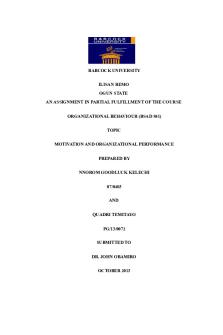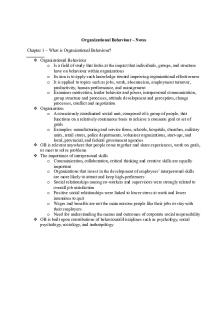Practice exam - organizational behaviour PDF

| Title | Practice exam - organizational behaviour |
|---|---|
| Author | nik papa |
| Course | Organizational Behavior |
| Institution | American College |
| Pages | 14 |
| File Size | 207.6 KB |
| File Type | |
| Total Downloads | 47 |
| Total Views | 169 |
Summary
Download Practice exam - organizational behaviour PDF
Description
Organizational Behaviour MCQ (50 Questions) 1.
A model is a(n) _____. a. abstraction of reality b. someone held in high esteem c. independent variable d. real-world scenario e. dependent variable (a; Moderate; Model; p. 26) 2.
At its root, productivity involves concern for both ____. a. dependence and independence b. diversity and homogeneity c. motivation and distraction d. absenteeism and motivation e. effectiveness and efficiency (e; Moderate; Productivity; p. 27) 3.
Which of the following is an example of being an efficient company? a. operating at the lowest possible cost while yielding a higher output b. creating the highest customer satisfaction ratings c. meeting the production schedule d. obtaining the highest market share e. maximizing diversity at high cost (a; Challenging; Productivity; p. 27) 4.
In general, _____ reinforcement schedules tend to lead to higher performance than _____ reinforcement schedules. a. variable; fixed b. fixed; intermittent c. fixed; variable d. variable; ratio e. fixed; static (a; Moderate; Intermittent Reinforcement; p. 60) 5.
The application of reinforcement concepts to individuals in the work setting is referred to as _____. a. classical conditioning b. self-management c. reengineering d. OB Mod e. social modeling (d; Moderate; OB Mod; p. 62) 6.
Which of the following is one of the steps of the problem-solving model followed by the typical OB Mod program? a. identifying critical behaviors b. reinforcing behavior c. developing horizontally arrayed data d. developing vertically arrayed data e. identifying member barriers (a; Moderate; OB Mod Steps; p. 62)
1
7.
Which of the following statements is not true about attitudes in the workplace? a. Changing employee attitudes is necessary if you are to manage dissonance. b. High pay alone is not likely to create a satisfying workplace. c. Generating positive job attitudes helps lower absenteeism and turnover. d. Attitudes help determine how well employees perform on the job e. Attitudes give warnings of potential problems (a; Moderate; Attitudes in the Workplace; pp. 85-90) 8.
An important moderator of the satisfaction-turnover relationship is the _____. a. employee’s level of performance b. organization’s culture c. management’s style d. employee’s values and attitudes e. employee’s level of workplace deviance (a; Challenging; Job Satisfaction and Turnover; p. 90) 9.
Why should managers be interested in their employees’ attitudes? a. They result from behavior. b. They cause problems. c. They give warnings of potential problems. d. They are generally low. e. They result in cognitive dissonance. (c; Moderate; Job Satisfaction and Implications for Managers; p. 92) 10.
Each of the six personality types developed in Holland’s personality-job fit theory has a ________. a. supplemental personality style b. congruent personality style c. congruent occupational environment d. supplemental occupational environment e. supplemental skill set (c; Challenging; Personality-Job Fit Theory; p. 122) 11.
The “realistic” personality from Holland’s typology of personality and congruent occupations would be well suited for which of the following jobs? a. painter b. accountant c. mechanic d. lawyer e. biologist (c; Moderate; Personality-Job Fit Theory; p. 122)
12.
What are consequences of a good fit between person and occupation? a. a low level of stress b. a high level of accomplishment c. high satisfaction and low turnover d. maximum performance and efficiency e. a high rate of turnover (c; Easy; Person-Organization Fit; p. 122)
2
13.
What is the segment of the three-component model of creativity that is the foundation for all creative work? a. expertise b. creative thinking skills c. intrinsic task motivation d. intuition e. realization (a; Moderate; Three-Component Model of Creativity; p. 159) 14.
What segment of the three-component model of creativity encompasses personality characteristics that are associated with imagination? a. expertise b. creative thinking skills c. intrinsic task motivation d. intuition e. realization (b; Moderate; Three-Component Model of Creativity; p. 159) 15.
What is the segment in the three-component model of creativity that turns creative potential into actual creative ideas? a. expertise b. creative thinking skills c. intrinsic task motivation d. intuition e. realization (c; Moderate; Three-Component Model of Creativity; p. 160)
16.
What is the term used for an individual’s personal evaluation of their ability to perform? a. expectancy b. autonomy c. self-efficacy d. task identity e. auto-discrimination (c; Easy; Self-Efficacy; p. 188) 17.
Which of the following is one of the relationships proposed in expectancy theory? a. reward-satisfaction relationship b. satisfaction-performance relationship c. rewards-personal goals relationship d. effort-satisfaction relationship e. performance-achievement relationship (c; Moderate; Rewards-Personal Goals Relationship; p. 197) 18.
According to expectancy theory, the degree to which organizational rewards satisfy an individual’s personal goals or needs and the attractiveness of those potential rewards for the individual is known as what sort of relationship? a. performance-reward b. effort-performance c. rewards-personal goals d. effort-satisfaction e. performance-achievement (c; Moderate; Rewards-Personal Goals Relationship; p. 197)
3
19.
Which of the following is not a typical option in a flexible benefit program? a. additional life insurance b. disability insurance c. expanded health coverage. d. tax free health care spending accounts e. mortgage relief (e; Easy; Flexible Benefits; p. 234) 20.
What are modular benefit plans? a. essential benefits and a menu-like selection of other benefits b. pre-designed packages of benefits c. they employees to set aside funds up to the dollar amount offered in the plan to pay for services d. a scheme designed for single employees with no dependents e. a scheme designed for employees with families (b; Moderate; Modular Benefit Plan; p. 234) 21.
Which of the following is a form of recognition? a. personal congratulations b. job enlargement c. job sharing d. flexible benefit packages e. profit sharing (a; Easy; Employee Recognition Programs; p. 235) 22.
Whether a candidate has high emotional intelligence would not be a significant factor when considering candidates for which of the following jobs? a. An interviewer who assesses candidates in an employment agency. b. An engineer heading up a team designing a complex software/hardware interface. c. A meeting planner who must set up meetings for candidates around the world. d. A copy-editor who seeks out spelling errors and grammatical mistakes in manuscripts. e. A realtor arranging sales between homeowners and potential buyers. (d; Moderate; Emotional Intelligence and Selection; p. 267) 23.
Studies show that people who are depressed tend to make poorer decisions than those with a more positive outlook. Why is this thought to be the case? a. They tend to choose an outcome that will confirm their negative worldview. b. They search for the perfect solution when rarely is any solution perfect. c. They rarely weigh up all the options when making a decision. d. They avoid stereotyping and other behaviors that allow them to come to a rapid decision. e. They tend to put too great a value on their own ability to affect outcomes. (b; Moderate; Emotional Intelligence and Decision Making; p. 268) 24.
Francine is the head of a group at an ad agency working with copywriters, artists, and designers to come up with effective branding of new products. Why is it particularly important for her to keep her team happy? a. People are more conscientious when they are in a good mood. b. People are more efficient when they are in a good mood. c. People are more productive when they are in a good mood. d. People are more cooperative when they are in a good mood. e. People are more creative when they are in a good mood. (e; Easy; Emotional Intelligence and Creativity; p. 268)
4
25. What term is used for the tendency for individuals to spend less effort when working collectively? a. groupthink b. the rule of diminishing returns c. social loafing d. groupshift e. clustering (c; Easy; Social Loafing; p. 299) 26.
Which of the following is a phenomenon in which group pressures for conformity deter the group from critically appraising unusual, minority, or unpopular views? a. group conformity b. groupshift c. groupthink d. compromise e. risk transfer (c; Easy; Groupthink; p. 304) 27.
What is brainstorming? a. a technique used to build group cohesiveness b. a technique that tends to restrict independent thinking c. a process for generating ideas d. a process used mainly when group members cannot agree on a solution e. the most effective means of generating answers (c; Easy; Brainstorming; p. 306) 28.
Coasting on the group effort is termed ____.
a. inconsistency b. incompetence c. social loafing d. dysfunction e. half-focus bias (c; Easy; Social Loafing; p. 337) 29.
If an employee is considered “untrainable” as a team member, he or she most likely_____. a. will be willing to undergo training in order to learn team skills b. can be successfully transferred from one team to another c. lacks the technical skills necessary for a team position d. will find it difficult to transition to working in teams e. comes from a culture that upholds collectivist values (d; Moderate; Selection; pp. 337-338) 30.
Exercises that help individuals become team players include workshops in _____. a. negotiation b. individualism c. goal setting d. event planning e. recruiting (a; Moderate; Training; p. 338)
5
31.
Receivers in communication see and hear based on their needs, motivations, experience, background, and other personal characteristics. This is called _____. a. communication apprehension b. filtering c. selective perception d. emotional block e. projection (c; Moderate; Selective Perception; p. 368) 32.
During the communication process, which of the following is most likely to result in lost information? a. information processing b. information overload c. information filtering d. effective communication e. the maximal effort effect (b; Moderate; Information Overload; p. 368)
33.
Communication _____ is the tension and anxiety about oral communication, written communication, or both. a. obstruction b. apprehension c. breakdown d. block e. frustration (b; Moderate; Communication Apprehension; p. 370) {AACSB: Communication} 34.
According to LMX theory, which of the following is not true of those individuals who fall into the out-group? a. They receive a disproportionate amount of the leader’s attention. b. They have leader-follower relations based on formal authority interaction. c. They are less trusted. d. They receive fewer of the preferred rewards that the leader controls. e. All of the above statements are true. (a; Easy; Leader-Member Exchange Theory; p. 399) 35.
According to LMX theory, a leader implicitly categorizes followers as “in” or “out” _____. a. after careful analysis b. on a temporary basis c. early in the interaction d. because of political pressure e. based on job requirements (c; Easy; Leader-Member Exchange Theory; p. 399) 36.
Vroom and Yetton’s leadership theory could also be described as a _____ theory. a. contingency b. decision c. behavioral d. trait e. cognitive dissonance (b; Moderate; Leadership-Participation Model; p. 400)
6
37.
Organizational characteristics that can be substitutes for leadership include all of the following except _____. a. explicit formalized goals b. rigid rules and procedures c. cohesive work groups d. mentor relationships e. All of the above can be substitutes for leadership. (d; Easy; Substitutes for Neutralizers of Leadership; p. 435) 38.
According to the text, which of the following skills should be included in leadership training? a. vision creation b. trust building c. situational analysis d. all of the above e. none of the above (d; Easy; Training Leaders; p. 436) 39.
Reactive and protective behaviors designed to avoid action, blame, or change are termed _____. a. political behaviors b. defensive behaviors c. protectionism d. impression management e. shielding bias (b; Moderate; Defensive Behaviors; p. 468) 40.
The process by which individuals attempt to control the perceptions that others form of them is called _____. a. impression management b. information management c. defensive behavior d. perception management e. reflection control (a; Easy; Impression Management; p. 469) 41.
What factor would most likely increase the negative impact of an arbitration session? a. limited options of the arbitrator b. heavy-handedness of the arbitrator c. compulsory nature of the arbitration d. voluntary nature of the arbitration e. establishment of an agreement that is non-binding (b; Moderate; Arbitration; p. 504) 42.
In third-party negotiations, a third party who provides an informal communication link between the negotiator and the opponent is known as a(n) _____. a. mediator b. arbitrator c. consultant d. conciliator e. executor (d; Moderate; Conciliator; p. 504)
7
43.
A company oriented around cost minimization is best served by which type of structure? a. virtual b. combination c. mechanistic d. organic e. targeted (c; Moderate; Strategy-Structure Relationship; p. 535) 44.
The _____ of an environment refers to the degree to which it can support growth. a. capacity b. qualifications c. potential d. capability e. permeability (a; Moderate; Capacity; p. 537) 45.
What does a positive organizational culture do? a. uses positive reinforcement instead of punishment b. rarely uses rewards c. emphasizes individual growth d. emphasizes building on the organization’s strengths e. emphasizes organizational vitality (c; Moderate; Creating a Positive Organizational Culture; p. 567) 46.
Organizations that promote a spiritual culture _____. a. have organized religious practices b. adopt a corporate religion c. recognize that people have both a mind and a spirit d. de-emphasize community in the work place e. tend to downplay the importance of employee satisfaction (c; Moderate; Workplace Spirituality and Organizational Culture; p. 570) 47.
The centerpiece of most diversity programs is _____. a. top management commitment b. employee commitment c. training d. human resource personnel e. employee satisfaction (c; Moderate; Diversity Training; p. 605) 48.
Diversity training programs are generally intended to provide a vehicle for _____. a. increasing awareness and examining stereotypes b. focusing on individual differences c. eliminating group learning d. balancing work/life conflicts e. socializing otherwise unmanageable employees (a; Moderate; Diversity Training; p. 605)
8
49.
Family issues, economic problems, and personality characteristics are examples of the _____ factor of potential stress. a. social b. environmental c. personnel d. psychological e. personal (e; Moderate; Personal Sources of Stress; p. 640) 50.
_____ is an example of an individual approach to stress reduction. a. Selection and placement b. Redesigning jobs c. Goal setting d. Relaxation techniques e. all of the above (d; Easy; Individual Approaches to Managing Stress; p. 645)
Short Questions (20 Questions) 1.
Discuss three different criteria for ethical decision making. There are three different criteria in making ethical choices. a) The first is the utilitarian criterion, in which decisions are made solely on the basis of their outcomes or consequences. The goal of utilitarianism is to provide the greatest good for the greatest number. This is the view that tends to dominate business decision making. b) Another criterion is to focus on rights. This calls on individuals to make decisions consistent with fundamental liberties and privileges as set forth in documents like the Bill of Rights. An emphasis on rights in decision making means respecting and protecting the basic rights of individuals. c) A third criterion is to focus on justice. This requires individuals to impose and enforce rules fairly and impartially so there is an equitable distribution of benefits and costs. (Moderate; Ethics; p. 157)
2.
What is self-efficacy? Self-efficacy refers to an individual’s belief that he or she is capable of performing a task. The higher your self-efficacy, the more confidence you have in your ability to succeed in a task. Individuals high in self-efficacy seem to respond to negative feedback with increased effort and motivation, while those low in self-efficacy are likely to lessen their effort when given negative feedback. (Easy; Self-Efficacy; p. 188)
9
3.
Explain the three job redesign options. a) Job rotation. This is the practice of periodically shifting an employee from one task to another. When an activity is no longer challenging, the employee is rotated to another job, usually at the same level, that has similar skill requirements. b) Job enlargement. This is the expansion of jobs horizontally; increasing the number and variety of tasks that an individual performs. Instead of only sorting the incoming mail by department, for instance, a mail sorter’s job could be enlarged to include physically delivering the mail to the various departments or running outgoing letters through the postage meter. c) Job enrichment. Job enrichment refers to the vertical expansion of jobs. It increases the degree to which the worker controls the planning, execution, and evaluation of his or her work. An enriched job organizes tasks so as to allow the worker to do a complete activity, increases the employee’s freedom and independence, increases responsibility, and provides feedback, so an individual will be able to assess and correct his or her own performance. (Moderate; Job Redesign; pp. 218-220)
4.
Discuss whether there are gender differences regarding emotions. The common belief is that women are more emotional than are men. Is there any truth to this? The evidence does confirm that women are more emotionally expressive than are men; they experience emotions more intensely; they tend to “hold onto” emotions longer than men, and they display more frequent expressions of both positive and negative emotions, except anger. Although there may be innate differences between the genders, research suggests that emotional differences also are due to the different ways men and women have been socialized. Men are taught to be tough and brave. Showing emotion is inconsistent with this image. Women, in contrast, are socialized to be nurturing. For instance, women are expected to express more positive emotions on the job (shown by smiling) than men, and they do. (Moderate; Emotions and Gender; p. 259) {AACSB: Analytic Skills}
5.
What is team efficacy? Effective teams have confidence in themselves. They believe they can succeed. This is called team efficacy. Teams that have been successful raise their beliefs about future success, which in turn, motivates them to work harder. (Easy; Team Efficacy; p. 336) {AACSB: Analytic Skills}
10
6.
What is communication apprehension? Communication apprehension is a major barrier to effective communication. People who suffer from communication apprehension experience undue tension and anxiety in oral communication, written communication, or both. (Easy; Communication Apprehension; p. 370) {AACSB: Communication} {AACSB: Analytic Skills}
...
Similar Free PDFs
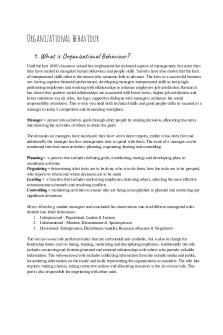
Organizational behaviour
- 67 Pages

Organizational Behaviour
- 2 Pages
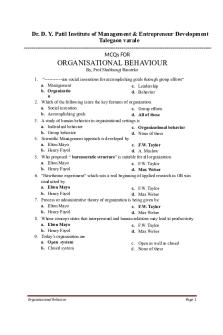
Organizational Behaviour mcqs
- 27 Pages
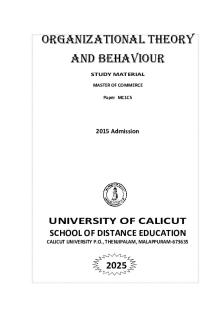
Organizational theory and behaviour
- 186 Pages
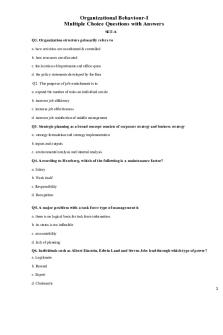
Organizational Behaviour MCQ SET
- 20 Pages
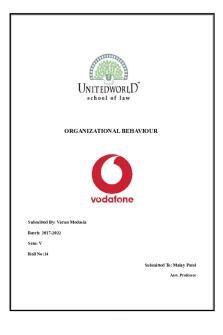
Organizational Behaviour Project
- 15 Pages

Chapter 2 ORGANIZATIONAL BEHAVIOUR
- 23 Pages

Organizational Behaviour Glossary
- 17 Pages
Popular Institutions
- Tinajero National High School - Annex
- Politeknik Caltex Riau
- Yokohama City University
- SGT University
- University of Al-Qadisiyah
- Divine Word College of Vigan
- Techniek College Rotterdam
- Universidade de Santiago
- Universiti Teknologi MARA Cawangan Johor Kampus Pasir Gudang
- Poltekkes Kemenkes Yogyakarta
- Baguio City National High School
- Colegio san marcos
- preparatoria uno
- Centro de Bachillerato Tecnológico Industrial y de Servicios No. 107
- Dalian Maritime University
- Quang Trung Secondary School
- Colegio Tecnológico en Informática
- Corporación Regional de Educación Superior
- Grupo CEDVA
- Dar Al Uloom University
- Centro de Estudios Preuniversitarios de la Universidad Nacional de Ingeniería
- 上智大学
- Aakash International School, Nuna Majara
- San Felipe Neri Catholic School
- Kang Chiao International School - New Taipei City
- Misamis Occidental National High School
- Institución Educativa Escuela Normal Juan Ladrilleros
- Kolehiyo ng Pantukan
- Batanes State College
- Instituto Continental
- Sekolah Menengah Kejuruan Kesehatan Kaltara (Tarakan)
- Colegio de La Inmaculada Concepcion - Cebu


